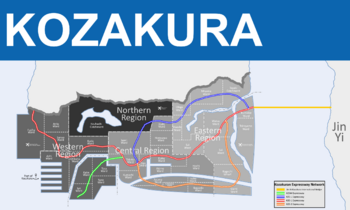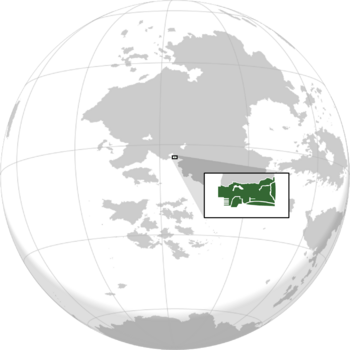Kozakura: Difference between revisions
| Line 147: | Line 147: | ||
The country’s executive leadership is made up of three individuals. The Tennō and Kampaku were part of the executive leadership, but are effectively without powers as the military takeover has deprived them of any meaningful political power. Shōgun Hideki Yamauchi is the incumbent leader of the Yamauchi bakufu, he succeeded his father, the preceding Shōgun, Koji Yamauchi, after his death in 2007. | The country’s executive leadership is made up of three individuals. The Tennō and Kampaku were part of the executive leadership, but are effectively without powers as the military takeover has deprived them of any meaningful political power. Shōgun Hideki Yamauchi is the incumbent leader of the Yamauchi bakufu, he succeeded his father, the preceding Shōgun, Koji Yamauchi, after his death in 2007. | ||
=== Judicial System === | === Judicial System === | ||
Kozakura's legal system is the Unified Code of Military Justice (''軍事司法の統一規範, Gunji shihō no tōitsu kihan''), the [[Kozakuran Armed Forces]]' military justice system. It has been in place since 1951 following Kozakura's defeat in the Great War. Post- | Kozakura's legal system is the Unified Code of Military Justice (''軍事司法の統一規範, Gunji shihō no tōitsu kihan''), the [[Kozakuran Armed Forces]]' military justice system. It has been in place since 1951 following Kozakura's defeat in the Great War. Post-war developments led to the previous civilian-led functions of the government were superseded by the governing organs established by the Sakurada Shogunate. The 1978 Coup, the rise of the Yamauchi Shogunate and the enactment of the Fukkatsu reforms led to revisions in the UCMJ, with the introduction of new categories of offenses that can be prosecuted under the General Article 888 of the UCMJ. The UCMJ was further revised in 2010 to further clarify financial crimes and improvements to sections regarding sexual assault. | ||
The head of the military justice system is the Judge Advocate General (''裁判官法廷将軍, Saibankan hōtei shōgun'') which also serves as a legal advisor for the Shogunate and serves in the Bakufu as the Head of Judicial Authority. | The head of the military justice system is the Judge Advocate General (''裁判官法廷将軍, Saibankan hōtei shōgun'') which also serves as a legal advisor for the Shogunate and serves in the Bakufu as the Head of Judicial Authority. | ||
Revision as of 22:12, 14 April 2024
This article is incomplete because it is pending further input from participants, or it is a work-in-progress by one author. Please comment on this article's talk page to share your input, comments and questions. Note: To contribute to this article, you may need to seek help from the author(s) of this page. |
State of Kozakura 小桜国 (Japanese) | |
|---|---|
 City Map | |
 Kozakura (in red circled) on the Southwestern Major Kistvach region | |
| Largest Ward | Akime |
| Official languages | Japanese |
| Ethnic groups | !Japanese !Chinese Orinami (Asian!Elves) Other |
| Demonym(s) | Kozakuran |
| Government | Unitary Absolute Monarchy (de jure) Military Dictatorship (de facto) |
• Emperor | Koji II |
• Shōgun | Hideki Yamauchi |
| Legislature | Civilian Consultative Council |
| Area | |
• Total | 900 km2 (350 sq mi) |
| Population | |
• 2034 estimate | 18,902,778 |
• Density | 21,003/km2 (54,397.5/sq mi) |
| GDP (nominal) | 2034 estimate |
• Total | $1.2 trillion R¥183.93 trillion |
• Per capita | $63,482.73 R¥9,730,315.44 |
| Gini (2034) | 45.9 medium |
| HDI (2034) | very high |
| Currency | Ryō, R¥ (KZR) |
| Driving side | left |
Kozakura, officially the State of Kozakura (!Japanese: 小桜国, Kozakura-koku), is a city-state situated in the western continent of Major Kistvach of Esvanovia. It shares a land border with the nation of Jin Yi to the east and the island nation of Chilokver to the west. The city state is governed by a military government (known as the Yamauchi bakufu) led by the Shōgun. The city-state’s head of state, the Emperor, is a ceremonial figurehead, having lost its authority to rule since the loss of the Kozakuran hinterlands in 19xx.
In 1978, a second military coup deposed the traditionalist members of the shogunate and was replaced by more modernist leaders. As Shōgun, Kōji Yamauchi oversaw the city-state’s transformation into a developed city-state with a high-income economy under his leadership. Kozakurans enjoy long life expectancies, fastest internet connection speeds, lowest infant mortality rates, and a low levels of corruption. Due to the military rule, its legal system is follows the city-state’s military legal code; the Unified Code of Military Justice. Despite its grip on power, the Shogunate has allowed the city-state to hold elections to elect members of the Civilian Consultative Council (!Japanese: 民管詩文評議会, Minkan shimon hyōgi-kai), part of the Fukkatsu reforms by Kōji Yamauchi.
The country's territory has increased 25% since the 1980 as a result of extensive land reclamation projects. It has one of the highest population density in the world although there are numerous green and recreational spaces as a result of urban planning.
History
Geography
Kozakura is situated on the tip of a small peninsula on southwestern coast of the continent of Major Kistvach within the Omitsu Bay.
Government and Politics
Before the Fukkatsu Reforms, the city-state was divided into several districts controlled by Director-Generals which controlled specific economic or military areas. In 1978, then-Director-General Koji Yamauchi received support from the other director-generals and overthrew the Bakufu of Kazuyuki Sakurada.
The new Bakufu of Koji Yamauchi brought sweeping reforms across the city state, combining the ten pre-reform districts into three large districts and within the districts are 35 wards. Geographic borders of these wards and districts are based on the major arterial roads.
Included in the political reforms of the Fukkatsu (Japanese: 復活, lit. Revival), is the formation of the Civilian Consultative Council. Its role is to legislate edicts, scrutinise and investigate all matters concerning the city-state.
The country’s executive leadership is made up of three individuals. The Tennō and Kampaku were part of the executive leadership, but are effectively without powers as the military takeover has deprived them of any meaningful political power. Shōgun Hideki Yamauchi is the incumbent leader of the Yamauchi bakufu, he succeeded his father, the preceding Shōgun, Koji Yamauchi, after his death in 2007.
Judicial System
Kozakura's legal system is the Unified Code of Military Justice (軍事司法の統一規範, Gunji shihō no tōitsu kihan), the Kozakuran Armed Forces' military justice system. It has been in place since 1951 following Kozakura's defeat in the Great War. Post-war developments led to the previous civilian-led functions of the government were superseded by the governing organs established by the Sakurada Shogunate. The 1978 Coup, the rise of the Yamauchi Shogunate and the enactment of the Fukkatsu reforms led to revisions in the UCMJ, with the introduction of new categories of offenses that can be prosecuted under the General Article 888 of the UCMJ. The UCMJ was further revised in 2010 to further clarify financial crimes and improvements to sections regarding sexual assault.
The head of the military justice system is the Judge Advocate General (裁判官法廷将軍, Saibankan hōtei shōgun) which also serves as a legal advisor for the Shogunate and serves in the Bakufu as the Head of Judicial Authority.
Re-established under the Fukkatsu reforms, the Courts Martial of Kozakura (小桜の軍法会議, Kozakura no gunpō kaigi) are independent and impartial tribunals and their hearings are open to the public. The UCMJ also provides the right for the prosecution and the offender convicted by the court martial to appeal decisions to the Military Court of Criminal Appeals.
Military
The Kozakuran Armed Forces (小桜軍団, Kozakura-gundan) is the military of the State of Kozakura, responsible for protecting and defending the security interests and the sovereignty of the city-state. Under the direct control of the Bakufu, the Armed Forces have four service branches, the Grand Army, Air Forces, and the Intelligence Services. It is headed by the Head of Operational Authority (!Japanese: 運営権限責任者, Un'ei kengen sekininsha) the second highest ranking person of the Bakufu. Kozakura maintains an annual mandatory spending $96 billion (R¥14.714 trillion) on its defence.
The KAF has an active military strength of 950 thousand and is capable of mobilising a wartime force of 1.2 million through its reservists, known as National Defence Auxiliary. The military also has a pool of conscripts that it can call upon through the National Service System.
Conscripts in the NSS are either former professional active or reserve personnel who opted to remain in the NSS after their term of service ended or citizens that reach 18 years old and is a requirement for various public programs and benefits including naturalisation, employment in the government, and job training.
| Service Branch |
Active Troops | National Defence Auxiliary |
National Service System Allocation |
|---|---|---|---|
| Kozakuran Grand Army 小桜軍 Kozakura-gun |
475,500 | 125,000 | 50% |
| Kozakuran Navy 小桜海軍 Kozakura-kaigun |
237,500 | 62,500 | 25% |
| Kozakuran Air Forces 小桜海軍, Kozakura-kūgun |
190,000 | 50,000 | 20% |
| Intelligence and Political Warfare Services 諜報および政治戦サービス, Chōhō oyobi seiji-sen sābisu |
47,000 | 12,500 | 5% |
| Total | 950,000 | 250,000 | 100% |
Law Enforcement
The Kozakuran Metropolitan Police Department (Keishichō) is the law enforcement agency in Kozakura, covering the capital district and the constituent metropolitan regions of the city state. The police manage 11 divisions and 112 stations across the city. The police also serve as the military police, responsible for law enforcement on military installations.
Economy
Kozakura has a highly developed market economy. The business sector included manufacturing industries, electronic technologies, security services, and so on. The Port of Kozakura is also one of the worlds’ busiest, as the city-state conducts entrepôt trade, where goods are imported, stored, or traded, usually to be exported again. Corporations were also one of the biggest contributors to the resurgence of the Kozakuran economy in the late 70’s. During the Fukkatsu reforms, restrictions on trade and conducting businesses were greatly reduced, and allowed foreign investment.
The Kozakuran economy is largely regarded as free and business friendly as the result of the economic reforms made under the Fukkatsu era which transformed it from an isolated and autarkic economy. Despite its market freedom, the Kozakuran government operations have a significant stake in the economy, contributing 19% of the GDP.
The currency of Kozakura is the Ryō (KZR, or R¥), issued by the Kozakuran Monetary Authority. While the city-state’s banknotes and coins are printed and minted by the city-state’s three largest banks, the KMA provides the banks the currency design and security requirements.

